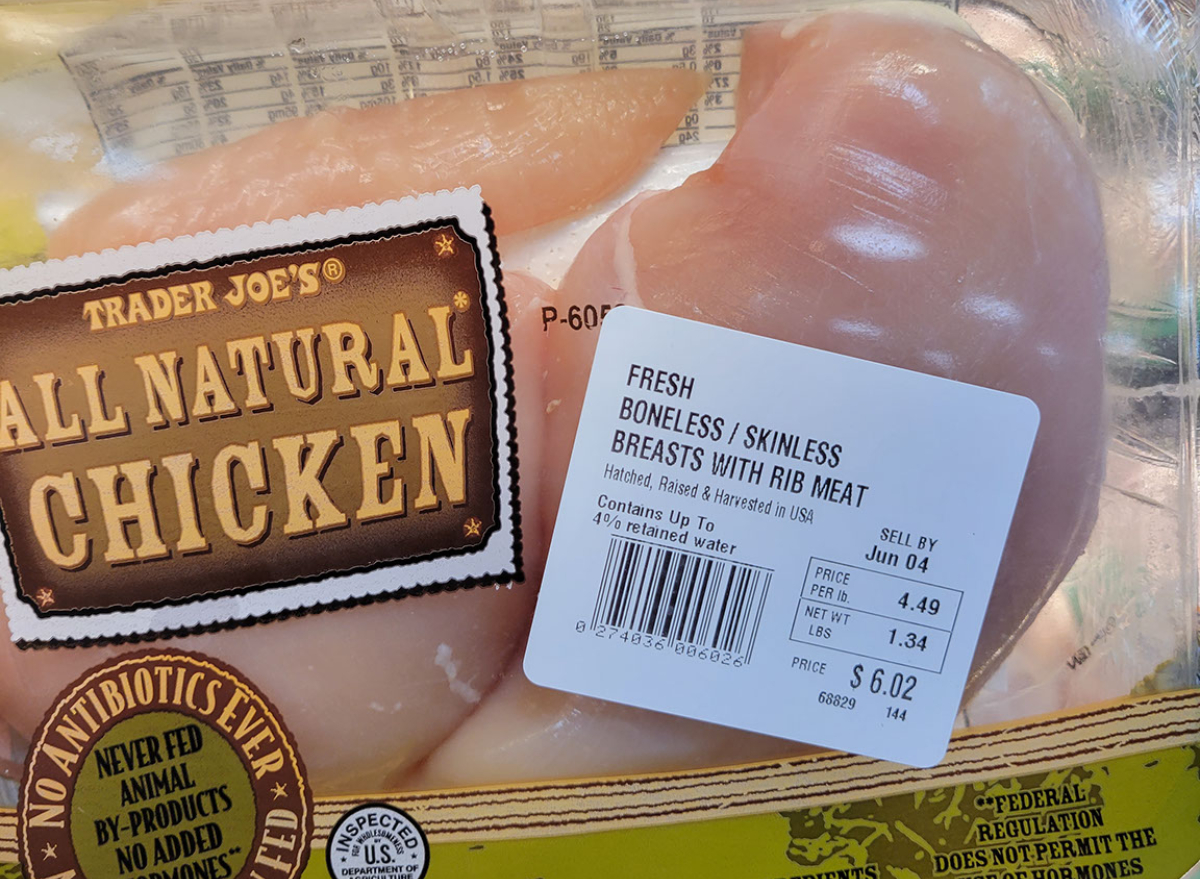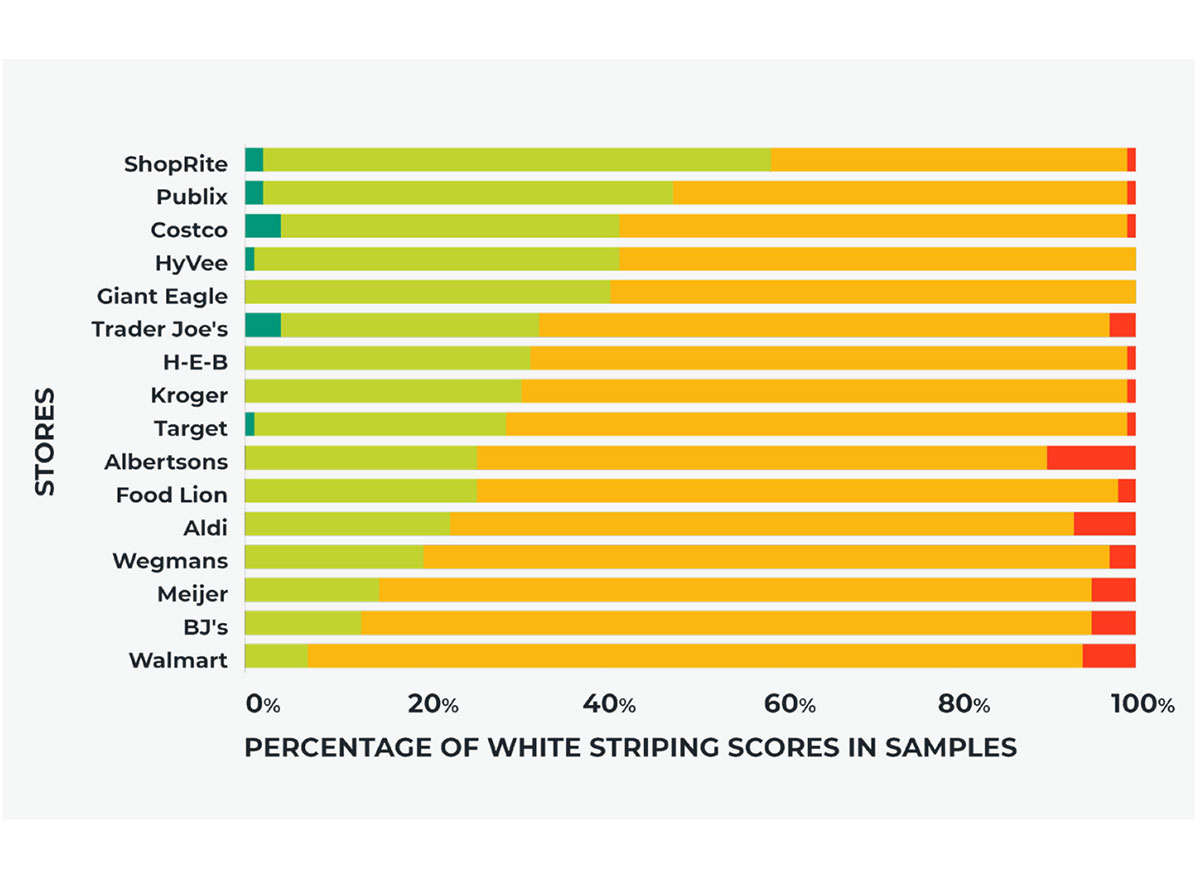99% of Store-Bought Chicken Is Affected by This Disease, New Report Says

If you're concerned about ingredients, nutrition, and the health of the food you buy, you may want to read this. A group has investigated samples of white-meat chicken at 16 national supermarket chains for evidence of a muscle disease that may impact the nutritional quality of store-bought chicken. Today, the investigators reveal the three well-known grocery chains that they say sold chickens with the greatest prevalence of the disease. Dr. Howard Grossman, MD, a member of the Eat This, Not That! medical expert board, shares what you should know about their findings.
The Humane League, a group advocating for animal welfare policies, has conducted an investigation on white striping disease in chicken. They say white striping disease is a muscle myopathy that occurs when chickens are bred for rapid growth. Keep reading to learn more about how the condition could affect the nutrition of the chicken you buy.
Also, don't miss the FDA's list of food recalls from the past week.
What is white striping disease in chickens?

The Humane League explains how white striping disease affects chickens' development: "Their muscles become inflamed and die from lack of oxygen. Their bodies replace this muscle tissue with fibrous tissue and fat. This changes the appearance and texture of the meat and, crucially, reduces the nutritional value of the meat by increasing the fat content."
According to the report, this condition affected less than 5% of chickens some 10 years ago. Today, however, it's far more prevalent. The group also cites data from the Sentience Institute that suggests consumers of chicken should be aware of white striping disease, as a reported 99% of all farm animals are raised on factory farms.
How white striping disease may affect nutrition

The Humane League suggests that white striping disease causes 224% higher fat content and 9% lower quality protein levels in chicken products consumers buy.
The method of investigation

In the spring, the group conducted an investigation on chicken breast fillet packets across 16 major U.S. supermarkets. Those were Walmart, Kroger, Costco, Albertsons, Ahold Delhaize, Publix, Target, H-E-B, Meijer, Aldi, Wakefern, Trader Joe's, HyVee, BJ's Wholesale Club, Wegmans, and Giant Eagle.
They examined between 76 and 154 samples of each supermarket's store brand of chicken breast. The samples were collected from store locations in 29 states, spanning from Washington to California and Maine to Florida.
Then, the investigators rated the levels of white striping in the supermarkets' chicken samples. A score of zero indicated chicken with the lowest levels of the disease, while a three indicated the highest.
Three major grocers sold chicken with the greatest prevalence of white striping disease

The Humane League reports that Walmart, Meijer, and BJs sold chickens with the highest levels of white striping present.
A sample of white striping disease in chicken

The white stripes of tissue are shown in this chicken that the Humane League says was sold at an Albertsons store. Albertsons' chicken gained a score of two in the investigation.
Among the chains selling healthier chicken…

Trader Joe's was among the chains that sold chicken containing the lowest levels of white striping.
Here's how the supermarket chains scored

Supermarkets with the highest and lowest levels of white striping, based on the Humane League's investigation, are visible in this chart, used with permission from the Humane League.
Is white striping disease in chicken bad for you and your family?

Dr. Howard Grossman, MD, a member of the Eat This, Not That! Medical Expert Board, sheds light on what this investigation means for the way you shop.
Grossman says the Humane League "is justified in pushing for more humane treatment of all animals including chickens. While they are clearly using the issue of white striping to promote better treatment of animals, it does not seem to have much of an impact on human health. It also appears that 'slow-growth' chicken can also show signs of white striping."
The bottom line for you, according to Dr. Grossman: "If people choose to only consume free-range and humanely bred chickens because they support better treatment of animals, that is a wonderful personal choice, but it does not seem to be a health issue for us."
A final note

A spokesperson for the Humane League tells Eat This, Not That! that thanks to findings like the ones in this report, more consumers may be inspired to make conscious diet changes: "[…C]onsumers should incorporate more plant-based options into their diets," they said.
For more of the latest food news, keep reading:









